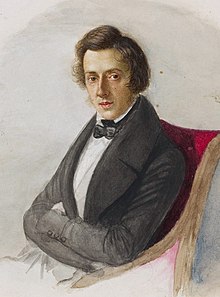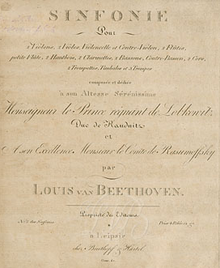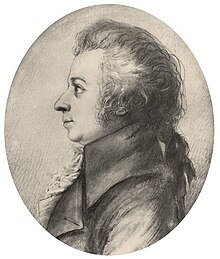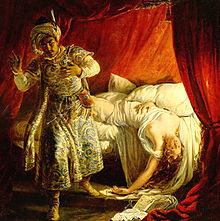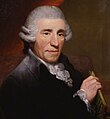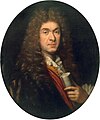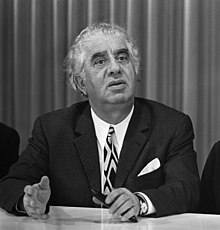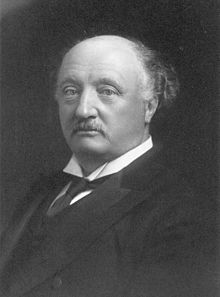Portal:Classical music
The Classical Music Portal


Classical music generally refers to the art music of the Western world, considered to be distinct from Western folk music or popular music traditions. It is sometimes distinguished as Western classical music, as the term "classical music" can also be applied to non-Western art musics. Classical music is often characterized by formality and complexity in its musical form and harmonic organization, particularly with the use of polyphony. Since at least the ninth century it has been primarily a written tradition, spawning a sophisticated notational system, as well as accompanying literature in analytical, critical, historiographical, musicological and philosophical practices. A foundational component of Western culture, classical music is frequently seen from the perspective of individual or groups of composers, whose compositions, personalities and beliefs have fundamentally shaped its history. (Full article...)
Selected articles -
-
The Piano Sonata No. 2 in B♭ minor, Op. 35, is a piano sonata in four movements by Polish composer Frédéric Chopin. Chopin completed the work while living in George Sand's manor in Nohant, some 250 km (160 mi) south of Paris, a year before it was published in 1840. The first of the composer's three mature sonatas (the others being the Piano Sonata No. 3 in B minor, Op. 58 and the Sonata for Piano and Cello in G minor, Op. 65), the work is considered to be one of the greatest piano sonatas of the literature.
The third movement of the Piano Sonata No. 2 is Chopin's famous funeral march (French: Marche funèbre; Polish: Marsz żałobny) which was composed at least two years before the remainder of the work and has remained, by itself, one of Chopin's most popular compositions. The Piano Sonata No. 2 carries allusions and reminiscences of music by J. S. Bach and by Ludwig van Beethoven; Beethoven's Piano Sonata No. 12 also has a funeral march as its third movement. A typical performance of Chopin's second sonata lasts between 21 and 25 minutes, depending on whether the repetition of the first movement's exposition is observed. (Full article...) -
The Symphony No. 5 in C minor, Op. 67, also known as the Fate Symphony (German: Schicksalssinfonie), is a symphony composed by Ludwig van Beethoven between 1804 and 1808. It is one of the best-known compositions in classical music and one of the most frequently played symphonies, and it is widely considered one of the cornerstones of western music. First performed in Vienna's Theater an der Wien in 1808, the work achieved its prodigious reputation soon afterward. E. T. A. Hoffmann described the symphony as "one of the most important works of the time". As is typical of symphonies during the Classical period, Beethoven's Fifth Symphony has four movements.
It begins with a distinctive four-note "short-short-short-long" motif, often characterized as "fate knocking at the door", the Schicksals-Motiv (fate motif): (Full article...) -
Symphonie fantastique: Épisode de la vie d'un artiste … en cinq parties (English: Fantastic Symphony: Episode in the Life of an Artist … in Five Sections) Op. 14, is a programmatic symphony written by Hector Berlioz in 1830. The first performance was at the Paris Conservatoire on 5 December 1830.
Berlioz wrote semi-autobiographical programme notes for the piece that allude to the romantic sufferings of a gifted artist who has poisoned himself with opium because of his unrequited love for a beautiful and fascinating woman (in real life, the Shakespearean actress Harriet Smithson, who in 1833 became the composer's wife). The composer, who revered Beethoven, followed the latter's unusual addition in the Pastoral Symphony of a fifth movement to the normal four of a classical symphony. The artist's reveries take him to a ball and to a pastoral scene in a field, which is interrupted by a hallucinatory march to the scaffold, leading to a grotesque satanic dance (witches' sabbath). Within each episode, the artist's passion is represented by a recurring theme called the idée fixe. (Full article...) -
The Sleeping Beauty (Russian: Спящая красавица, romanized: Spyashchaya krasavitsa listen) is a ballet in a prologue and three acts to music by Pyotr Ilyich Tchaikovsky, his Opus 66, completed in 1889. It is the second of his three ballets and, at 160 minutes, his second-longest work in any genre. The original scenario was by Ivan Vsevolozhsky after Perrault's La belle au bois dormant, or The Beauty Sleeping in the Forest; the first choreographer was Marius Petipa. The premiere took place at the Mariinsky Theatre in St. Petersburg on January 15, 1890, and from that year forward The Sleeping Beauty has remained one of the most famous of all ballets. (Full article...)
-
The piano is a keyboard instrument that produces sound when its keys are depressed, through engagement of an action whose hammers strike strings. Most pianos have a row of 88 black and white keys, representing each note of the chromatic scale as they repeat throughout the keyboard's span of seven and a quarter octaves. There are 52 white keys, known as “naturals”, and 36 black keys, known as “sharps”. The naturals repeat a pattern of whole steps and half steps unique to any given starting note. These patterns define a diatonic scale. The 36 sharps repeat a pattern of whole steps and minor thirds, which defines a pentatonic scale.
We commonly think of the white notes as outlining the C-Major scale, but this is happenstance. Major scales are always composed of notes that ascend, from any given starting key (whether black or white), in this order: whole step, whole step, half step, whole step, whole step, whole step, and half step. It just happens that when we begin on a ‘C’, this pattern exists entirely on the white notes. (Full article...) -
The Symphony No. 9 in D minor, Op. 125, is a choral symphony, the final complete symphony by Ludwig van Beethoven, composed between 1822 and 1824. It was first performed in Vienna on 7 May 1824. The symphony is regarded by many critics and musicologists as a masterpiece of Western classical music and one of the supreme achievements in the history of music. One of the best-known works in common practice music, it stands as one of the most frequently performed symphonies in the world.
The Ninth was the first example of a major composer scoring vocal parts in a symphony. The final (4th) movement of the symphony, commonly known as the Ode to Joy, features four vocal soloists and a chorus in the parallel key of D major. The text was adapted from the "An die Freude (Ode to Joy)", a poem written by Friedrich Schiller in 1785 and revised in 1803, with additional text written by Beethoven. In the 20th century, an instrumental arrangement of the chorus was adopted by the Council of Europe, and later the European Union, as the Anthem of Europe. (Full article...) -
Eine kleine Nachtmusik (Serenade No. 13 for strings in G major), K. 525, is a 1787 composition for a chamber ensemble by Wolfgang Amadeus Mozart (1756–1791). The German title means "a little night music". The work is written for an ensemble of two violins, viola, cello and double bass, but is often performed by string orchestras. The serenade is one of Mozart's most famous works. (Full article...) -

The harp is a stringed musical instrument that has individual strings running at an angle to its soundboard; the strings are plucked with the fingers. Harps can be made and played in various ways, standing or sitting, and in orchestras or concerts. Its most common form is triangular in shape and made of wood. Some have multiple rows of strings and pedal attachments.
Ancient depictions of harps were recorded in Mesopotamia (now Iraq), Persia (now Iran) and Egypt, and later in India and China. By medieval times harps had spread across Europe. Harps were found across the Americas where it was a popular folk tradition in some areas. Distinct designs also emerged from the African continent. Harps have symbolic political traditions and are often used in logos, including in Ireland. (Full article...) -

The violoncello (/ˌvaɪələnˈtʃɛloʊ/ VY-ə-lən-CHEL-oh, Italian pronunciation: [vjolonˈtʃɛllo]), often simply abbreviated as cello (/ˈtʃɛloʊ/ CHEL-oh), is a bowed (sometimes plucked and occasionally hit) string instrument of the violin family. Its four strings are usually tuned in perfect fifths: from low to high, C2, G2, D3 and A3. The viola's four strings are each an octave higher. Music for the cello is generally written in the bass clef, with tenor clef, and treble clef used for higher-range passages.
Played by a cellist or violoncellist, it enjoys a large solo repertoire with and without accompaniment, as well as numerous concerti. As a solo instrument, the cello uses its whole range, from bass to soprano, and in chamber music such as string quartets and the orchestra's string section, it often plays the bass part, where it may be reinforced an octave lower by the double basses. Figured bass music of the Baroque era typically assumes a cello, viola da gamba or bassoon as part of the basso continuo group alongside chordal instruments such as organ, harpsichord, lute, or theorbo. Cellos are found in many other ensembles, from modern Chinese orchestras to cello rock bands. (Full article...) -
The saxophone (often referred to colloquially as the sax) is a type of single-reed woodwind instrument with a conical body, usually made of brass. As with all single-reed instruments, sound is produced when a reed on a mouthpiece vibrates to produce a sound wave inside the instrument's body. The pitch is controlled by opening and closing holes in the body to change the effective length of the tube. The holes are closed by leather pads attached to keys operated by the player. Saxophones are made in various sizes and are almost always treated as transposing instruments. A person who plays the saxophone is called a saxophonist or saxist.
The saxophone is used in a wide range of musical styles including classical music (such as concert bands, chamber music, solo repertoire, and occasionally orchestras), military bands, marching bands, jazz (such as big bands and jazz combos), and contemporary music. The saxophone is also used as a solo and melody instrument or as a member of a horn section in some styles of rock and roll and popular music. (Full article...) -

The clarinet is a single-reed musical instrument in the woodwind family, with a nearly cylindrical bore and a flared bell.
Clarinets comprise a family of instruments of differing sizes and pitches. The clarinet family is the largest woodwind family, ranging from the BB♭ contrabass to the E♭ soprano. The B♭ soprano clarinet is the most common type, and is the instrument usually indicated by the word "clarinet". (Full article...) -
Otello (Italian pronunciation: [oˈtɛllo]) is an opera in four acts by Giuseppe Verdi to an Italian libretto by Arrigo Boito, based on Shakespeare's play Othello. It was Verdi's penultimate opera, first performed at the Teatro alla Scala, Milan, on 5 February 1887.
The composer was reluctant to write anything new after the success of Aida in 1871, and he retreated into retirement. It took his Milan publisher Giulio Ricordi the next ten years, first to encourage the revision of Verdi's 1857 Simon Boccanegra by introducing Boito as librettist and then to begin the arduous process of persuading and cajoling Verdi to see Boito's completed libretto for Otello in July/August 1881. However, the process of writing the first drafts of the libretto and the years of their revision, with Verdi all along not promising anything, dragged on. It wasn't until 1884, five years after the first drafts of the libretto, that composition began, with most of the work finishing in late 1885. When it finally premiered in Milan on 5 February 1887, it proved to be a resounding success, and further stagings of Otello soon followed at leading theatres throughout Europe and America. (Full article...)
General images -
-
Portrait of Beethoven by Joseph Karl Stieler, 1820 (from Classical period (music))
-
Daguerreotype of Chopin, c. 1849 (from Romantic music)
-
Balakirev (top), Cui (upper left), Mussorgsky (upper right), Rimsky-Korsakov (lower left), and Borodin (lower right). (from Romantic music)
-
A young Wolfgang Amadeus Mozart, a representative composer of the Classical period, seated at a keyboard. (from Classical period (music))
-
Individual sheet music for a seventeenth-century harp. (from Baroque music)
-
Painting by Evaristo Baschenis of Baroque instruments, including a cittern, viola da gamba, violin, and two lutes (from Baroque music)
-
Bizet photographed by Étienne Carjat (1875) (from Romantic music)
-
Franz Liszt in 1858 by Franz Hanfstaengl (from Romantic music)
-
Robert Schumann in an 1850 daguerreotype (from Romantic music)
-
A group of Renaissance musicians in The Concert (1623) by Gerard van Honthorst (from Renaissance music)
-
Claudio Monteverdi in 1640 (from Baroque music)
-
Hummel in 1814 (from Classical period (music))
-
Portrait of Mendelssohn by James Warren Childe, 1839 (from Classical period (music))
-
The opening bars of the Commendatore's aria in Mozart's opera Don Giovanni. The orchestra starts with a dissonant diminished seventh chord (G# dim7 with a B in the bass) moving to a dominant seventh chord (A7 with a C# in the bass) before resolving to the tonic chord (D minor) at the singer's entrance. (from Classical period (music))
-
Johann Sebastian Bach, 1748 (from Baroque music)
-
Wolfgang Amadeus Mozart, posthumous painting by Barbara Krafft in 1819 (from Classical period (music))
-
Double-manual harpsichord by Vital Julian Frey, after Jean-Claude Goujon (1749) (from Baroque music)
-
1875 oil painting of Franz Schubert by Wilhelm August Rieder, after his own 1825 watercolor portrait (from Classical period (music))
-
Portion of Du Fay's setting of Ave maris stella, in fauxbourdon. The top line is a paraphrase of the chant; the middle line, designated "fauxbourdon", (not written) follows the top line but exactly a perfect fourth below. The bottom line is often, but not always, a sixth below the top line; it is embellished, and reaches cadences on the octave.Play (from Renaissance music)
-
Josef Danhauser's 1840 painting of Franz Liszt at the piano surrounded by (from left to right) Alexandre Dumas, Hector Berlioz, George Sand, Niccolò Paganini, Gioachino Rossini and Marie d'Agoult, with a bust of Ludwig van Beethoven on the piano (from Romantic music)
-
Musicians from 'Procession in honour of Our Lady of Sablon in Brussels.' Early 17th-century Flemish alta cappella. From left to right: bass dulcian, alto shawm, treble cornett, soprano shawm, alto shawm, tenor sackbut. (from Renaissance music)
-
Haydn portrait by Thomas Hardy, 1792 (from Classical period (music))
-
Gustav Mahler, photographed in 1907 by Moritz Nähr at the end of his period as director of the Vienna Hofoper (from Romantic music)
-
The Mozart family c. 1780. The portrait on the wall is of Mozart's mother. (from Classical period (music))
-
Gluck, detail of a portrait by Joseph Duplessis, dated 1775 (Kunsthistorisches Museum, Vienna) (from Classical period (music))
-
Richard Wagner in Paris, 1861
-
View of Vienna in 1758, by Bernardo Bellotto (from Classical period (music))
-
Bernhard Crusell, a Swedish-Finnish composer and clarinetist, in 1826 (from Classical period (music))
-
A modern string quartet. In the 2000s, string quartets from the Classical era are the core of the chamber music literature. From left to right: violin 1, violin 2, cello, viola (from Classical period (music))
-
A large instrumental ensemble's performance in the lavish Teatro Argentina, as depicted by Panini (1747) (from Baroque music)
-
Marc-Antoine Charpentier (from Baroque music)
-
Wanderer above the Sea of Fog, by Caspar David Friedrich, is an example of Romantic painting. (from Romantic music)
-
Fortepiano by Paul McNulty after Walter & Sohn, c. 1805 (from Classical period (music))
Quotes -
| “ | The aim of music is not to express feelings but to express music. | ” |
| — Pierre Boulez | ||
Related portals
WikiProjects
-
Zhou Bangyan (Chinese: 周邦彥; 1056–1121) was a Chinese musician, poet, and politician of the Northern Song Dynasty. He was from Qiantang (in modern Hangzhou). His courtesy name was Meicheng (Chinese: 美成; pinyin: Měichéng), and his art name was Qingzhen Jushi (Chinese: 清真居士; pinyin: Qīngzhēn Jūshì). He left a two-volume poetry anthology called either the Qingzhen-ji or the Pianyu-ci. (Full article...)
-
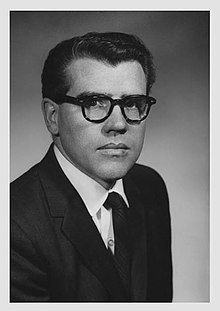
Merrill Bradshaw in 1963
Merrill Bradshaw (June 18, 1929 – July 12, 2000) was an American composer and professor at Brigham Young University (BYU), where he was composer-in-residence from 1967 to 1994.
Bradshaw grew up in Lyman, Wyoming; Salt Lake City, Utah; and Portland, Oregon. He was a member of the Church of Jesus Christ of Latter-day Saints (LDS Church). He studied music theory at BYU with John R. Halliday and others, after which he continued his studies in composition at the University of Illinois. He became a faculty member at BYU in 1957. He was chairman of composition and theory from 1973 to 1983, and the executive director of the Barlow Endowment for Music Composition from 1983 to 1999. From 1973 to 1978 he chaired an LDS Church committee to revise the hymnbook, although the committee was suspended before they published their intended hymnal. A different committee authored the 1985 hymnal. (Full article...) -

A l’arme A l’arme by Grimace, verso 55 from the Chantilly Codex
Grimace (fl. mid-to-late 14th century; French: [ɡʁi.mas]; also Grymace, Grimache or Magister Grimache) was a French composer-poet in the ars nova style of late medieval music. Virtually nothing is known about Grimace's life other than speculative information based on the circumstances and content of his five surviving compositions of formes fixes; three ballades, a virelai and rondeau. His best known and most often performed work in modern-times is the virelai and proto-battaglia: A l’arme A l’arme.
He is thought to have been a younger contemporary of Guillaume de Machaut and based in southern France. Three of his works were included in the Chantilly Codex, which is an important source of ars subtilior music. However, along with P. des Molins, Jehan Vaillant and F. Andrieu, Grimace was one of the post-Machaut generation whose music shows few distinctly ars subtilior features, leading scholars to recognize Grimace's work as closer to the ars nova style of Machaut. (Full article...) -
Garry Schyman is an American film, television, and video game music composer. He graduated from the University of Southern California with a degree in music composition in 1978, and began work in the television industry, writing music for such television series as Magnum, P.I. and The A-Team. By 1986, he was composing for movies such as Judgement and Hit List. At the request of a friend in 1993, he composed the music for the video game Voyeur, but after creating the music for two more games he left the industry, citing the low budgets and poor quality of video game music at the time. He continued to compose for film and television, only to return to video games for 2005's Destroy All Humans!. Finding that in his absence the quality and perceived importance of video game music had risen substantially, he has since composed for several games, writing the scores to BioShock and Dante's Inferno among others. He still composes for film however, his latest being Brush with Danger directed by young Indonesian director Livi Zheng. He has won numerous awards for his video game scores, including several "soundtrack of the year" awards. During his career, he has worked on over 25 television shows, 10 films, and 13 video games. (Full article...) -
Clara Josephine Schumann ([ˈklaːʁa ˈʃuːman]; née Wieck; 13 September 1819 – 20 May 1896) was a German pianist, composer, and piano teacher. Regarded as one of the most distinguished pianists of the Romantic era, she exerted her influence over the course of a 61-year concert career, changing the format and repertoire of the piano recital by lessening the importance of purely virtuosic works. She also composed solo piano pieces, a piano concerto (her Op. 7), chamber music, choral pieces, and songs.
She grew up in Leipzig, where both her father Friedrich Wieck and her mother Mariane were pianists and piano teachers. In addition, her mother was a singer. Clara was a child prodigy, and was trained by her father. She began touring at age eleven, and was successful in Paris and Vienna, among other cities. She married the composer Robert Schumann, on 12 September 1840, and the couple had eight children. Together, they encouraged Johannes Brahms and maintained a close relationship with him. She gave the public premieres of many works by her husband and by Brahms. (Full article...) -

Imogen Clare Holst CBE (née von Holst; 12 April 1907 – 9 March 1984) was a British composer, arranger, conductor, teacher, musicologist, and festival administrator. The only child of the composer Gustav Holst, she is particularly known for her educational work at Dartington Hall in the 1940s, and for her 20 years as joint artistic director of the Aldeburgh Festival. In addition to composing music, she wrote composer biographies, much educational material, and several books on the life and works of her father.
From a young age, Holst showed precocious talent in composing and performance. After attending Eothen School and St Paul's Girls' School, she entered the Royal College of Music, where she developed her skills as a conductor and won several prizes for composing. Unable to follow her initial ambitions to be a pianist or a dancer for health reasons, Holst spent most of the 1930s teaching, and as a full-time organiser for the English Folk Dance and Song Society. These duties reduced her compositional activities, although she made many arrangements of folksongs. After serving as an organiser for the Council for the Encouragement of Music and the Arts at the start of the Second World War, in 1942 she began working at Dartington. In her nine years there she established Dartington as a major centre of music education and activity. (Full article...) -
Aram Ilyich Khachaturian (/ˈærəm ˌkɑːtʃəˈtʊəriən/; Russian: Арам Ильич Хачатурян, IPA: [ɐˈram ɨˈlʲjitɕ xətɕɪtʊˈrʲan] ; Armenian: Արամ Խաչատրյան, Aram Xačatryan; 6 June [O.S. 24 May] 1903 – 1 May 1978) was a Soviet Armenian composer and conductor. He is considered one of the leading Soviet composers.
Born and raised in Tbilisi (now the capital of Georgia), Khachaturian moved to Moscow in 1921 following the Sovietization of the Caucasus. Without prior music training, he enrolled in the Gnessin Musical Institute, subsequently studying at the Moscow Conservatory in the class of Nikolai Myaskovsky, among others. His first major work, the Piano Concerto (1936), popularized his name within and outside the Soviet Union. It was followed by the Violin Concerto (1940) and the Cello Concerto (1946). His other significant compositions include the Masquerade Suite (1941), the Anthem of the Armenian SSR (1944), three symphonies (1935, 1943, 1947), and around 25 film scores. Khachaturian is best known for his ballet music—Gayane (1942) and Spartacus (1954). His most popular piece, the "Sabre Dance" from Gayane, has been used extensively in popular culture and has been performed by a number of musicians worldwide. His style is "characterized by colorful harmonies, captivating rhythms, virtuosity, improvisations, and sensuous melodies". (Full article...) -
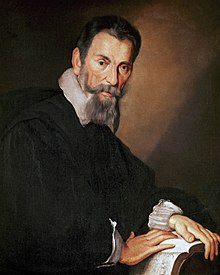
Monteverdi by Bernardo Strozzi (c. 1630) 
Claudio Giovanni Antonio Monteverdi (baptized 15 May 1567 – 29 November 1643) was an Italian composer, choirmaster and string player. A composer of both secular and sacred music, and a pioneer in the development of opera, he is considered a crucial transitional figure between the Renaissance and Baroque periods of music history.
Born in Cremona, where he undertook his first musical studies and compositions, Monteverdi developed his career first at the court of Mantua (c. 1590–1613) and then until his death in the Republic of Venice where he was maestro di cappella at the basilica of San Marco. His surviving letters give insight into the life of a professional musician in Italy of the period, including problems of income, patronage and politics. (Full article...) -
Yasunori Mitsuda (光田 康典, Mitsuda Yasunori, born January 21, 1972) is a Japanese composer and musician. He is best known for his work in video games, primarily for the Chrono, Xeno, Shadow Hearts, and Inazuma Eleven franchises, among various others. Mitsuda began composing music for his own games in high school, later attending a music college in Tokyo. While still a student, he was granted an intern position at the game development studio Wolf Team.
Mitsuda joined Square upon graduation in 1992 and worked there as a sound effects designer for two years before telling Square's vice president Hironobu Sakaguchi he would quit unless he could write music for their games. Shortly after, Sakaguchi assigned him to work on the soundtrack for Chrono Trigger (1995), whose music has since been cited as among the best in video games. (Full article...) -
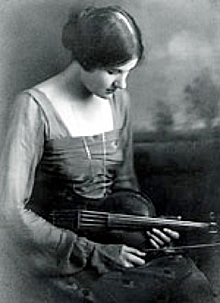
Clarke with a viola in 1919
Rebecca Helferich Clarke (27 August 1886 – 13 October 1979) was a British classical composer and violist. Internationally renowned as a viola virtuoso, she also became one of the first female professional orchestral players in London.
Rebecca Clarke had German and American parents, and spent substantial periods of her life in the United States, where she permanently settled after World War II. She was born in Harrow and studied at the Royal Academy of Music and Royal College of Music in London. Stranded in the United States at the outbreak of World War II, she married composer and pianist James Friskin in 1944. Clarke died at her home in New York at the age of 93. (Full article...) -

A 1611 woodcut of Josquin des Prez, possibly copied from a now-lost oil painting made during his lifetime. There have been doubts concerning whether this depiction is an accurate likeness, see § Portraits.
Josquin Lebloitte dit des Prez (c. 1450–1455 – 27 August 1521) was a composer of High Renaissance music, who is variously described as French or Franco-Flemish. Considered one of the greatest composers of the Renaissance, he was a central figure of the Franco-Flemish School and had a profound influence on the music of 16th-century Europe. Building on the work of his predecessors Guillaume Du Fay and Johannes Ockeghem, he developed a complex style of expressive—and often imitative—movement between independent voices (polyphony) which informs much of his work. He further emphasized the relationship between text and music, and departed from the early Renaissance tendency towards lengthy melismatic lines on a single syllable, preferring to use shorter, repeated motifs between voices. Josquin was a singer, and his compositions are mainly vocal. They include masses, motets and secular chansons.
Josquin's biography has been continually revised by modern scholarship, and remains highly uncertain. Little is known of his early years; he was born in the French-speaking area of Flanders, and he may have been an altar boy and have been educated at the Cambrai Cathedral, or taught by Ockeghem. By 1477 he was in the choir of René of Anjou and then probably served under Louis XI of France. Now a wealthy man, in the 1480s Josquin traveled Italy with the Cardinal Ascanio Sforza, may have worked in Vienna for the Hungarian king Matthias Corvinus, and wrote the motet Ave Maria ... Virgo serena, and the popular chansons Adieu mes amours and Que vous ma dame. He served Pope Innocent VIII and Pope Alexander VI in Rome, Louis XII in France, and Ercole I d'Este in Ferrara. Many of his works were printed and published by Ottaviano Petrucci in the early 16th century, including the Missa Hercules Dux Ferrariae. In his final years in Condé, Josquin produced some of his most admired works, including the masses Missa de Beata Virgine and Missa Pange lingua; the motets Benedicta es, Inviolata, Pater noster–Ave Maria and Praeter rerum seriem; and the chansons Mille regretz, Nimphes, nappés and Plus nulz regretz. (Full article...) -

Edward Elgar, c. 1900
Sir Edward William Elgar, 1st Baronet, OM, GCVO (/ˈɛlɡɑːr/ ; 2 June 1857 – 23 February 1934) was an English composer, many of whose works have entered the British and international classical concert repertoire. Among his best-known compositions are orchestral works including the Enigma Variations, the Pomp and Circumstance Marches, concertos for violin and cello, and two symphonies. He also composed choral works, including The Dream of Gerontius, chamber music and songs. He was appointed Master of the King's Musick in 1924.
Although Elgar is often regarded as a typically English composer, most of his musical influences were not from England but from continental Europe. He felt himself to be an outsider, not only musically, but socially. In musical circles dominated by academics, he was a self-taught composer; in Protestant Britain, his Roman Catholicism was regarded with suspicion in some quarters; and in the class-conscious society of Victorian and Edwardian Britain, he was acutely sensitive about his humble origins even after he achieved recognition. He nevertheless married the daughter of a senior British Army officer. She inspired him both musically and socially, but he struggled to achieve success until his forties, when after a series of moderately successful works his Enigma Variations (1899) became immediately popular in Britain and overseas. He followed the Variations with a choral work, The Dream of Gerontius (1900), based on a Roman Catholic text that caused some disquiet in the Anglican establishment in Britain, but it became, and has remained, a core repertory work in Britain and elsewhere. His later full-length religious choral works were well received but have not entered the regular repertory. (Full article...) -
Valerie Muriel Rodway (February 12, 1919 – August 1970) was a Guyanese composer of cultural and patriotic songs, inspired by the events leading up to Guyana's independence in 1966. She is best known for composing music to accompany Guyana national poetry, like Arise, Guyana, Kanaïma, and the Martin Carter's Guyanese Independence poem Let Freedom Awaken. For the next two decades, school children were taught the songs she and others composed to inspire patriotism and cultural affinity. She selected the poetry for her compositions based upon her principles and values, first developed among her parents and siblings.
She has been considered Guyana's greatest composer of patriotic and national music, and among the best composers from Guyana of the 20th century, generally and among composers of classical music. She was awarded the Wordsworth McAndrew Award posthumously in 2002. In 2019, she was awarded the Cacique Crown of Honor, one of the highest honors of Guyana. The National Trust of Guyana building in Cummingsburg, Georgetown, has been renamed the Valerie Rodway House in her honor. (Full article...) -
Sir John Stainer
Sir John Stainer (6 June 1840 – 31 March 1901) was an English composer and organist whose music, though seldom performed today (with the exception of The Crucifixion, still heard at Passiontide in some Anglican churches), was very popular during his lifetime. His work as choir trainer and organist set standards for Anglican church music that are still influential. He was also active as an academic, becoming Heather Professor of Music at Oxford.
Stainer was born in Southwark, London, in 1840, the son of a schoolmaster. He became a chorister at St Paul's Cathedral when aged ten and was appointed to the position of organist at St Michael's College, Tenbury, at the age of sixteen. He later became organist at Magdalen College, Oxford, and subsequently organist at St Paul's Cathedral. When he retired owing to his poor eyesight and deteriorating health, he returned to Oxford to become Professor of Music at the university. He died unexpectedly while on holiday in Italy in 1901. (Full article...) -
Philibert Rabezoza (1923 – 29 September 2001), better known by the name Rakoto Frah, was a flautist and composer of traditional music of the central highlands of Madagascar. Born in 1923 near the capital city of Antananarivo to a poor rural family, Rakoto Frah surmounted the challenges posed by his underprivileged origins to become the most acclaimed 20th century performer of the sodina flute, one of the oldest traditional instruments on the island. Through frequent international concerts and music festival performances, he promoted the music of the highlands of Madagascar and became one of the most famous Malagasy artists, both within Madagascar and on the world music scene.
After gaining regional recognition for his sodina skills as a youth, Rakoto Frah rose to national fame in 1958 when he was selected by Malagasy President Philibert Tsiranana to perform on the sodina for the visiting French president Charles de Gaulle. This event launched his career as a professional musician. He first played at traditional ceremonies around the country, then expanded his performances from 1967 to include participation in international music competitions and festivals. His popularity declined in the 1970s but underwent a revival that began in the mid-1980s and continued until his death in 2001. During this period Rakoto Frah recorded ten albums, toured extensively in Madagascar and overseas, was featured in two French documentaries, and collaborated with a variety of international and Malagasy artists. Over the course of his career he recorded over 800 original compositions. Rakoto Frah and his sodina were depicted on the 200 ariary Malagasy banknote in honor of his key role in revitalizing and internationally popularizing the sodina. Despite the artist's worldwide acclaim, he lived simply and died having earned little from his lifetime of musicianship. His death was widely mourned and marked by a state funeral, and in 2011 a famadihana (the Malagasy highland "turning of the bones" funerary tradition) was organized to celebrate the artist's life. (Full article...)
Did you know (auto-generated) -

- ... that WFMT classical music radio host Don Tait owned such a large collection of recordings that he had to buy a house and have its floor reinforced to accommodate the weight?
- ... that opera singer Charles Holland spent much of his career in Europe as opportunities in classical music for African Americans were limited?
- ... that the conductor Im Won-sik is considered the "father of Korea's classical music world"?
- ... that the Stadthalle Hannover, the largest classical music concert hall in Germany by capacity, was modelled after the Pantheon in Rome and completed by 1914?
- ... that the choral music of Artemy Vedel, who is regarded as one of the Golden Three composers of 18th-century Ukrainian classical music, was censored but performed from handwritten copies?
- ... that in 1994, Anthony Pople created two computer programs to analyse classical music?
Selected image
-

A picture of the first theatre drawn shortly before it burned down in 1808.
The Royal Opera House is an opera house and major performing arts venue in the London district of Covent Garden. The large building, often referred to as simply "Covent Garden", is the home of The Royal Opera, The Royal Ballet and the Orchestra of the Royal Opera House. -
Photo: W. J. Mayer; Restoration: Lise BroerA bust of the German composer and pianist Ludwig van Beethoven (1770–1827), made from his death mask. He was a crucial figure in the transitional period between the Classical and Romantic eras in Western classical music, and remains one of the most acclaimed and influential composers of all time. Born in Bonn, of the Electorate of Cologne and a part of the Holy Roman Empire of the German Nation in present-day Germany, he moved to Vienna in his early twenties and settled there, studying with Joseph Haydn and quickly gaining a reputation as a virtuoso pianist. His hearing began to deteriorate in the late 1790s, yet he continued to compose, conduct, and perform, even after becoming completely deaf.
-
Photograph credit: William P. Gottlieb; restored by Adam CuerdenBilly Strayhorn (November 29, 1915 – May 31, 1967) was an American jazz composer, pianist, lyricist, and arranger, best remembered for his long-time collaboration with bandleader and composer Duke Ellington that lasted nearly three decades. Though classical music was Strayhorn's first love, his ambition to become a classical composer went unrealized because of the harsh reality of a black man trying to make his way in the world of classical music, which at that time was almost completely white. He was introduced to the music of pianists like Art Tatum and Teddy Wilson at age 19, and the artistic influence of these musicians guided him into the realm of jazz, where he remained for the rest of his life. This photograph of Strayhorn was taken by William P. Gottlieb in the 1940s.
-
 The Teatro alla Scala (or La Scala, as it is known), in Milan, Italy, is one of the world's most famous opera houses. The theatre was inaugurated on 3 August 1778, under the name Nuovo Regio Ducal Teatro alla Scala with Salieri's Europa riconosciuta.
The Teatro alla Scala (or La Scala, as it is known), in Milan, Italy, is one of the world's most famous opera houses. The theatre was inaugurated on 3 August 1778, under the name Nuovo Regio Ducal Teatro alla Scala with Salieri's Europa riconosciuta. -
Sheet music for the Polonaise in A-flat major, Op. 53, a solo piano piece written by Frédéric Chopin in 1842. This work is one of Chopin's most admired compositions and has long been a favorite of the classical piano repertoire. The piece, which is very difficult, requires exceptional pianistic skills and great virtuosity to be interpreted. A typical performance of the polonaise lasts seven minutes.
-
Photo: Guillaume PiolleThe anatomy of a Périnet piston valve, this one taken from a B♭ trumpet. When depressed, the valve diverts the air stream through additional tubing, thus lengthening the instrument and lowering the harmonic series on which the instrument is vibrating (i.e., it lowers the pitch). Trumpets generally use three valves, with some variations, such as a piccolo trumpet, having four. When used singly or in combination, the valves make the instrument fully chromatic, or capable of playing all twelve pitches of classical music. Trumpets may also use rotary valves instead.
-
Photograph: David IliffThe Royal Albert Hall is a concert hall, seating a maximum of 5,272, on the northern edge of South Kensington, London. Constructed beginning in 1867, the hall was inaugurated on 29 March 1871. Since 1941 it has held The Proms, an eight-week summer season of daily orchestral classical music concerts and other events.
-
Painting: Thomas GainsboroughJohann Christian Bach (5 September 1735 – 1 January 1782) was a composer of the Classical era, the eighteenth child of Johann Sebastian Bach, and the youngest of his eleven sons. Bach was taught by his father and then, after the latter's death, by his half-brother C. P. E. Bach. Bach moved to Italy in 1754, and then to London in 1762, where he became known as the "London Bach". Bach's compositions include eleven operas, as well as chamber music, orchestral music and compositions for keyboard music. In 1764 Bach met Wolfgang Amadeus Mozart, who was eight at the time, and spent five months teaching him composition. He had considerable influence on Mozart, and was later described by scholars as his "only, true teacher".
This portrait of Bach was painted in 1776 by Thomas Gainsborough, as part of a collection started by Bach's former teacher Padre Martini. It now hangs in the National Portrait Gallery, London. -
Photograph credit: Eugène Pirou; restored by Adam CuerdenJules Massenet (12 May 1842 – 13 August 1912) was a French composer of the Romantic era, best known for his operas. Between 1867 and his death, he wrote more than forty stage works in a wide variety of styles, from opéra comique to grand depictions of classical myths, romantic comedies and lyric dramas, as well as oratorios, cantatas and ballets. Massenet had a good sense of the theatre and of what would succeed with the Parisian public. Despite some miscalculations, he produced a series of successes that made him the leading opera composer in France in the late 19th and early 20th centuries. By the time of his death, he was regarded as old-fashioned; his works, however, began to be favourably reassessed during the mid-20th century, and many have since been staged and recorded. This photograph of Massenet was taken by French photographer Eugène Pirou in 1875.
-
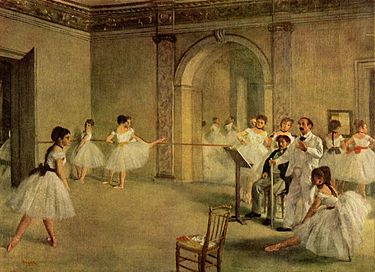 Ballet is a formalized form of dance with its origins in the French court, further developed in France and Russia as a concert dance form.
Ballet is a formalized form of dance with its origins in the French court, further developed in France and Russia as a concert dance form. -
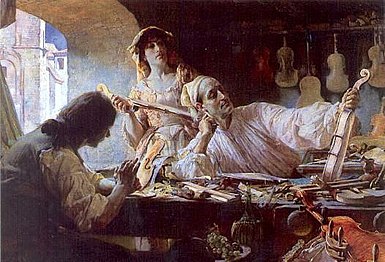 Stradivarius is one of the violins, violas, cellos and other string instruments built by members of the Italian Stradivari family, particularly Antonio Stradivari.
Stradivarius is one of the violins, violas, cellos and other string instruments built by members of the Italian Stradivari family, particularly Antonio Stradivari.
Topics
Things you can do
Associated Wikimedia
The following Wikimedia Foundation sister projects provide more on this subject:
-
Commons
Free media repository -
Wikibooks
Free textbooks and manuals -
Wikidata
Free knowledge base -
Wikinews
Free-content news -
Wikiquote
Collection of quotations -
Wikisource
Free-content library -
Wikiversity
Free learning tools -
Wiktionary
Dictionary and thesaurus


